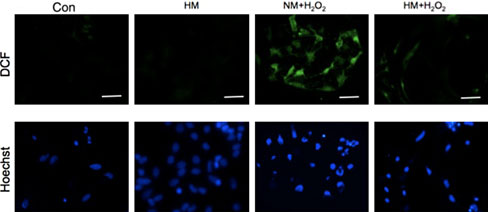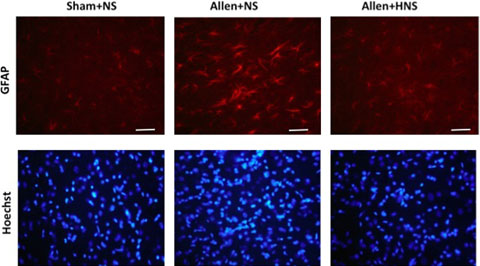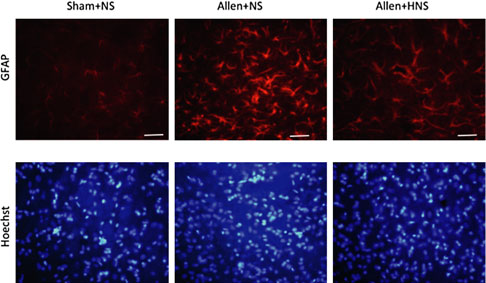博文
氢气通过抑制星形胶质细胞氧化损伤治疗脊髓损伤
||
Molecular Hydrogen Suppresses Reactive Astrogliosis Related to.pdf
氢气治疗脊髓损伤最早是上海长征医院麻醉科袁红斌教授课题组证明的,最近该课题组在原来研究的基础上,进一步从星形胶质细胞氧化损伤角度,阐述氢治疗脊髓损伤的细胞学机制。
星形胶质细胞是中枢神经系统内重要的胶质细胞,在各类中枢神经损伤的发病过程中都具有重要作用,脊髓损伤后,数分钟到数小时内,组织大量释放各种类型的活性氧,是导致神经元和星形胶质细胞发生死亡和变化的重要因素,也是各种神经系统疾病研究中关注的重要问题。组织损伤时,星形胶质细胞激活,可以释放多种炎症因子加剧组织炎症反应,而且可以因为细胞增生形成神经组织疤痕,这种变化会导致永久性组织功能的障碍,是脊髓损伤后功能障碍的重要原因。
由于活性氧增加和氧化应激不仅是星形胶质细胞激活的重要诱发因素,也是后续炎症反应的重要介质,因此抗氧化治疗是该领域一直尝试的新手段。
氢气生物学效应主要的基础是选择性抗氧化,大量研究证明,氢气对各种急性慢性氧化损伤、炎症和细胞凋亡等相关疾病具有理想的治疗效果。该课题组也曾经证明,注射氢水能有效治疗脊髓创伤,但对治疗效果的细胞学基础并不十分清楚。本次研究主要针对星形胶质细胞激活这一病理变化开展研究,采用形态学、分子生物学和生物化学等手段,证明氢水治疗后脊髓星形胶质细胞激活可明显受到抑制,相关信号分子出现相应改变,研究提示,氢气治疗脊髓损伤可能是通过减少氧化损伤抑制星形胶质细胞激活发挥作用。当然脊髓损伤发生的细胞学改变相当复杂,例如小胶质细胞和少突胶质细胞都发挥重要作用,因此需要更多研究阐述氢治疗脊髓损伤的分子和细胞学基础。



CNS Neurosci Ther. 2014 Mar 31. doi: 10.1111/cns.12258. [Epub ahead of print]
Molecular Hydrogen Suppresses Reactive Astrogliosis Related to Oxidative Injury during Spinal Cord Injury in Rats.
Liu FT1, Xu SM, Xiang ZH, Li XN, Li J, Yuan HB, Sun XJ.
Spinal cord injury (SCI) can induce excessive astrocyte activation. Hydrogen has been deemed as a novel antioxidant. We investigated whether molecular hydrogen could act as an antiastrogliosis agent during SCI and oxidative injury in experimental rats and cultured astrocytes.
Hydrogen-rich saline (HS, 8 mL/kg, i.p.) was injected every 12 h after SCI in rats. The expression of STAT3, p-STAT3, and glial fibrillary acidic protein (GFAP); the release of IL-1β, IL-6, and TNF-α; and astrogliosis, along with the BBB score, were evaluated. Culturing astrocytes with hydrogen-rich medium, the intracellular reactive oxygen species (ROS), astrogliosis, and the release of proinflammatory cytokines were assessed after H2 O2 -induced injury.
In the HS group, the expression of STAT3, p-STAT3, and GFAP and the proinflammatory cytokines were decreased in local spinal cord on postoperation day (POD) 3; on PODs 7 and 14, reactive astrogliosis was suppressed, and the locomotor function was also improved. Furthermore, hydrogen-rich medium attenuated the intracellular production of ROS (especially HO•), astrogliosis, and the secretion of proinflammatory cytokines in astrocytes 12 h after H2 O2 -induced injury.
Molecular hydrogen could suppress reactive astrogliosis after contusive SCI and reduce the release of proinflammatory cytokines produced by active astrocytes related to oxidative injury. Thus, molecular hydrogen is potential to be a neuroprotective agent.
相关文献
https://blog.sciencenet.cn/blog-41174-781688.html
上一篇:表观遗传组学研究在行动
下一篇:科普活动中遭遇的尴尬